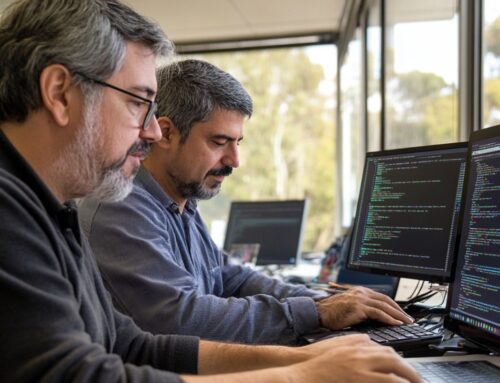Nearshore vs Offshore Staff Augmentation For SaaS Companies: What Works Best
Nearshore vs Offshore Staff Augmentation For SaaS Companies: What Works Best
Article-At-A-Glance
What’s the best model for SaaS staff augmentation: nearshore or offshore?
Nearshore staff augmentation offers time zone alignment, cultural fit, and stronger compliance support. Offshore may reduce costs, but often increases communication risks. This guide helps SaaS leaders weigh the pros and cons to make a smart, strategic scaling decision.

Scaling a SaaS company demands flexibility, top-tier software development talent, and accelerated delivery speed. I’ve worked with multiple SaaS teams that hit the same wall, needing to move fast but struggling to find developers who could truly keep up. Nearshore staff augmentation often became our go-to strategy when internal teams couldn’t scale fast enough.
But when deciding between nearshore and offshore options, many tech leaders are left wondering which model best supports agility, collaboration, and sustainable growth.
I’ve seen firsthand how the right fit accelerates velocity and improves communication, while the wrong one creates delays and frustration. The choice you make will shape not only delivery timelines, but also how your culture scales with your team.
What’s the Difference Between Nearshore and Offshore?
The global tech talent shortage has made staff augmentation not just a trend, but a necessity for fast-growing SaaS organizations. Choosing the right nearshore or offshore sourcing model has implications that go far beyond cost. It directly affects product velocity, communication efficiency, customer satisfaction, and even long-term team morale.
Understanding the operational trade-offs between nearshore and offshore models is key to making a strategic decision that supports long-term success.
Nearshore staff augmentation (a strategic model for hiring regional developers) refers to hiring talent from neighboring or nearby countries, typically within the same time zone or just a few hours apart. For US-based SaaS firms, this often means Latin America.
Offshore augmentation (a global outsourcing model for cost-efficiency) means tapping into teams from distant regions, like Asia or Eastern Europe, where labor costs are significantly lower but time zones and cultural differences are more pronounced.
Nearshore vs Offshore: Where the Real Gaps Show Up
| Criteria | Nearshore Staff Augmentation | Offshore Staff Augmentation |
|---|---|---|
| Time Zone Overlap | High (real-time collaboration possible) | Low (asynchronous communication often required) |
| Communication Clarity | Strong cultural and language alignment | Requires more adjustment and process rigor |
| Response Time | Fast (within same or close work hours) | Slower (delays common due to time difference) |
| Cost per Hour | Moderate to High | Low |
| Developer Retention | Higher (due to cultural fit and engagement) | Lower (often more transactional relationships) |
| Compliance Alignment | Strong (better alignment with US/Canada) | Variable (depends on provider and region) |
| Best Use Case | Agile SaaS teams needing flexibility | Stable, well-documented long-term projects |
Nearshore teams offer key advantages that directly impact speed and clarity. They operate in similar time zones, which supports real-time interaction during business hours. This naturally aligns with Agile workflows, where daily standups and quick pivots are essential.
💡 Pro Tip: Look for nearshore partners that have experience integrating with Agile teams. Ask how they handle sprint planning, backlog grooming, and daily syncs to evaluate how seamless the collaboration will be.
Additionally, cultural familiarity plays a critical role. Nearshore developers are often fluent in U.S. workplace communication norms and development practices, which reduces onboarding friction and increases collaboration.
Responsiveness is another differentiator. When issues arise, nearshore partners can react in sync with your team’s working hours, helping resolve blockers in real-time rather than the next day.
Keep in Mind: Offshore can still be effective for well-documented projects, but coordination delays and time zone gaps increase risk for Agile SaaS teams.
A McKinsey report noted that companies that prioritized talent alignment and collaboration across time zones were 30% more likely to meet product development goals on time. This reinforces how time zone proximity in nearshore teams is not just a convenience. It’s a performance lever. (source)
In my experience, communication gaps with offshore teams often emerge during sprint planning and QA. A subtle misunderstanding can delay a deployment by days. With nearshore teams, it’s easier to resolve blockers in the moment, without waiting for overlapping hours.
💡 Pro Tip: When evaluating time zone alignment, don’t just look at hours. Test how collaboration actually works in practice by piloting daily standups and real-time code reviews with your nearshore candidates.
Communication Nuances: Styles vary, so align early. Share your preferred communication cadence and meeting culture early to avoid misalignment.
Is Saving Money Costing You More?
💡 Pro Tip: Don’t let low hourly rates distract you from long-term cost implications. Ask your potential partners about past rework incidents and how they handle missed sprints or project pivots.
While offshore rates often appear more budget-friendly, the hidden costs of misalignment and rework can quickly erase those savings. In contrast, nearshore teams might charge higher hourly rates, but they usually deliver faster iterations, improved retention, and fewer misunderstandings.
A recent Deloitte study found that 70% of companies choose outsourcing primarily to cut costs, but 40% reported quality concerns that impacted performance and client satisfaction. These concerns often stemmed from misaligned time zones and unclear communication expectations, which are key challenges of offshore models. (source)
Cost vs Value Summary: Nearshore isn’t the cheapest upfront, but often leads to better ROI, faster roadmaps, and happier users.
Scaling Smart: Where to Find the Right Talent, Fast
Let’s break down where nearshore and offshore models truly diverge across a few practical areas:
Communication: Nearshore teams typically work in similar time zones, allowing for real-time interaction during business hours. Offshore teams often require delayed communication or overnight updates.
Cultural Familiarity: Teams from nearshore regions are more likely to understand U.S. workplace norms, such as direct feedback and Agile collaboration styles.
Responsiveness: When dealing with production issues or pivoting strategy, nearshore partners tend to respond faster, reducing downtime and accelerating fixes.
This doesn’t mean offshore can’t work, but the added layers of time difference, cultural adaptation, and asynchronous coordination can raise the stakes, especially for fast-moving SaaS teams.
💡 Pro Tip: Want to attract top-tier nearshore talent? Build your employer brand in their region. Participate in local tech events, sponsor developer meetups, and promote your engineering values publicly.
A McKinsey report noted that companies that prioritized talent alignment and collaboration across time zones were 30% more likely to meet product development goals on time. This reinforces how time zone proximity in nearshore teams is not just a convenience. It’s a performance lever. (source)
In my experience, communication gaps with offshore teams often emerge during sprint planning and QA. A subtle misunderstanding can delay a deployment by days. With nearshore teams, it’s easier to resolve blockers in the moment, without waiting for overlapping hours.
Unique to Nearshore Hiring: One advantage of nearshore hiring is the ability to build stronger employer branding in regional markets. Unlike offshore strategies where teams may work with multiple international clients simultaneously, nearshore professionals often seek longer-term engagements with companies they identify with.
This creates an opening for SaaS companies to stand out by promoting engineering culture, innovation roadmaps, and career development paths directly within the nearshore ecosystem. Localizing outreach and engaging in regional tech events helps attract high-caliber candidates aligned with your mission.
If your SaaS company needs to scale fast and maintain quality, you’ll need more than just hands on keyboards. You’ll need engineers who understand your product vision, communicate proactively, and solve problems without micromanagement.
💡 Pro Tip: Use onboarding as a litmus test. If your nearshore team quickly adopts your tools, integrates into your Slack channels, and joins sprint reviews with clarity, that’s a strong indicator they’ll thrive long-term.
Don’t Let Compliance Kill Your Deal
Compliance and regulatory alignment can be deal-breakers for SaaS companies working with sensitive user data. I’ve worked with clients that nearly lost enterprise contracts because offshore partners didn’t follow SOC 2 protocols or lacked familiarity with regional data privacy laws.
Nearshore teams, particularly in Latin America, are often more in tune with North American compliance standards, making it easier to pass audits and meet legal requirements without added friction.
💡 Pro Tip: During vetting, ask your nearshore partner to walk you through their compliance playbook, including how they manage audits, certifications, and regulatory training.
This isn’t just about GDPR or HIPAA. It’s about reducing risk and liability during audits, acquisitions, or investor due diligence.
Signs Nearshore Is Your Best Bet
In my experience, SaaS leaders who favor Agile cycles and tight iteration loops consistently find nearshore teams more dependable. The advantage isn’t just in hours. It’s in cultural compatibility, mutual expectations, and the ability to co-own outcomes.
One CTO I worked with described their nearshore team as ‘an extension of our in-house engineers,’ not just contractors. That level of integration is hard to achieve across 12-hour time differences.
- You require real-time collaboration
- Your product roadmap changes often
- You need to onboard quickly with minimal friction
- You operate in a heavily regulated industry
When Offshore Can Still Win
💡 Pro Tip: Offshore teams work best with mature product pipelines. If your roadmap is stable and well-documented, you can tap into cost savings without losing quality.
- You have clearly defined, long-term projects
- You need to reduce costs for non-core tasks
- You have robust asynchronous processes in place
- You’re prepared to invest in cross-cultural training and communication
Final Thoughts: Choose Strategy Over Geography
💡 Pro Tip: Don’t overanalyze. Start small with a pilot project using a nearshore partner, then measure how collaboration, speed, and code quality perform.
Choosing between nearshore and offshore isn’t just about location, it’s about alignment. The best staff augmentation model for a SaaS company balances cost with collaboration, speed with quality, and access with accountability.
Recommendation: Start with a small, high-impact project. Test the waters with a nearshore team and measure how it affects velocity, product quality, and team morale. SaaS success isn’t just about code. It’s about communication, iteration, and trust.
Frequently Asked Questions (FAQ)
What is the difference between nearshore and offshore staff augmentation?
Nearshore staff augmentation involves partnering with teams in nearby countries with similar time zones and cultural alignment, while offshore augmentation typically means working with teams in distant regions with lower labor costs but greater time zone and communication challenges.
Is nearshore staff augmentation more expensive than offshore?
Yes, hourly rates for nearshore developers are usually higher than offshore teams, but many SaaS companies find that the reduced friction and faster delivery lead to better long-term ROI.
Why is time zone alignment important for SaaS teams?
Agile development thrives on real-time collaboration. Having teams in similar time zones allows for daily standups, faster feedback loops, and quicker resolution of blockers.
Can offshore development still work for SaaS companies?
Absolutely. Offshore teams can be effective for well-defined, long-term projects where asynchronous workflows are already in place. The key is to ensure strong documentation and clear communication protocols.
What makes nearshore teams better for compliance-heavy SaaS products?
Nearshore providers, especially in Latin America, are more likely to be aligned with U.S. and European compliance standards such as SOC 2 and GDPR, which reduces risk during audits or due diligence.
Find Talent Now
Your decision between nearshore and offshore can shape the future of your product. If you’re leaning toward nearshore augmentation, now is the time to act. DevNearshore specializes in connecting SaaS companies with high-performing development teams across Latin America.
Whether you’re launching a new product or scaling an existing platform, our tailored nearshore solutions can provide the agility, alignment, and expertise you need to move faster with confidence.
Contact DevNearshore to explore how we can support your growth with reliable, high-quality engineering talent.
Legal Disclaimer
This article is intended for informational purposes only and does not constitute legal, financial, or compliance advice. Readers should consult with qualified professionals to assess specific business needs, local regulations, or contractual obligations before making staff augmentation decisions.





